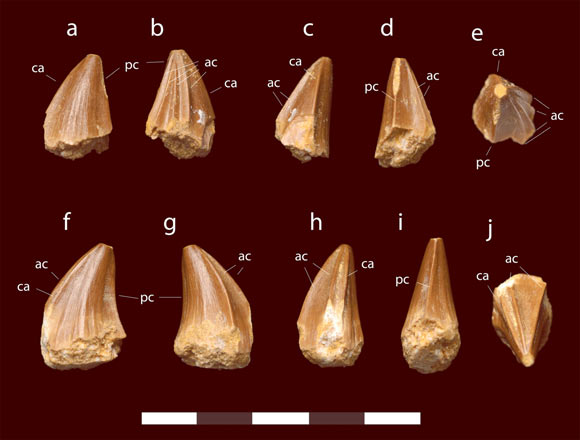Paleontologists have described an unusual new species of mosasaur based on a fossilized partial jaw and associated tooth crowns from phosphatic deposits at Sidi Chennane, Oulad Abdoun Basin, Morocco.
The newly-discovered mosasaur swam in the Late Cretaceous seas of Morocco, approximately 67 million years ago.
Dubbed Stelladens mysteriosus, the ancient reptile was around twice the size of a dolphin.
It had a unique tooth arrangement with blade-like ridges running down the teeth, arranged in a star-shaped pattern, reminiscent of a cross-head screwdriver.
Most mosasaurs had two bladelike, serrated ridges on the front and back of the tooth to help cut prey, however Stelladens mysteriosus had anywhere from four to six of these blades running down the tooth.
“It’s a surprise,” said lead author Dr. Nick Longrich, a paleontologist at the University of Bath.
“It’s not like any mosasaur, or any reptile, even any vertebrate we’ve seen before.”
No close analogues to the unique tooth morphology of Stelladens mysteriosus are known, either living or extinct.
It may have had an unusual and highly specialized diet, a specialized prey-capture strategy, or both.
“We have no idea what this animal was eating, because we don’t know of anything similar either alive today, or from the fossil record,” Dr. Longrich said.
“It’s possible it found a unique way to feed, or maybe it was filling an ecological niche that simply doesn’t exist today.”
“The teeth look like the tip of a Phillips-head screwdriver, or maybe a hex wrench.”

Teeth of Stelladens mysteriosus. Scale bar – 5 cm. Image credit: Longrich et al., doi: 10.3390/fossils1010002.
The teeth of Stelladens mysteriosus were small, but stout and with wear on the tips, which seemed to rule out soft-bodied prey.
The teeth weren’t strong enough to crush heavily armored animals like clams or sea urchins, however.
“That might seem to suggest it’s eating something small, and lightly armored — thin-shelled ammonites, crustaceans, or bony fish — but it’s hard to know,” Dr. Longrich said.
“There were weird animals living in the Cretaceous — ammonites, belemnites, baculites — that no longer exist.”
“It’s possible this mosasaur ate something, and occupied a niche, that simply doesn’t exist anymore, and that might explain why nothing like this is ever seen again.”
“Evolution isn’t always predictable. Sometimes it goes off in a unique direction, and something evolves that’s never been seen before, and then it never evolves again.”
Mosasaurs evolved around 100 million years ago, and diversified up to 66 million years ago, when a giant asteroid hit the Yucatan Peninsula in Mexico, plunging the world into darkness.
Although scientists have debated the role of environmental changes towards the end of the Cretaceous in the extinction, Stelladens mysteriosus, along with recent discoveries from of Morocco, suggests that mosasaurs were evolving rapidly up to the very end — they went out at their peak, rather than fading away.
“The fauna has produced an incredible number of surprises — mosasaurs with teeth arranged like a saw, a turtle with a snout in the form of snorkel, a multitude of vertebrates of various shapes and sizes, and now a mosasaur with star-shaped teeth,” said co-author Professor Nour-Eddine Jalil, a paleontologist at the French Muséum National d’Histoire Naturelle and the Université Cadi Ayyad Marrakech.
The discovery is reported in a paper in the journal Fossils.
_____
Nicholas R. Longrich et al. 2023. Stelladens mysteriosus: A Strange New Mosasaurid (Squamata) from the Maastrichtian (Late Cretaceous) of Morocco. Fossils 1 (1): 2-14; doi: 10.3390/fossils1010002








